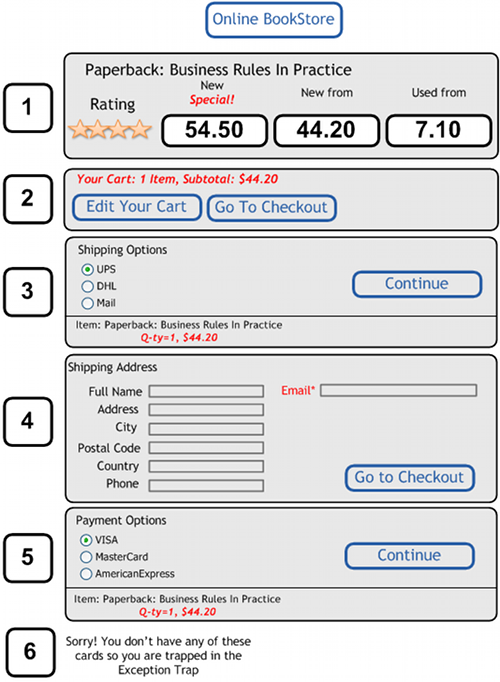Business rule model: an example to illustrate model components
After publishing the business rule model poster last week, we received a suggestion from Adriana Beal to provide an example that would illustrate the components of the model. Let’s consider a real life situation, purchasing a book from an online store (with an added constraint of no more than 10 items per customer). Here are the steps a customer would go through to make a purchase:

The business rules applied during the process are as follows:
-
A book can be bought as either new or used by a customer from any location.
-
Up to 10 items of the selected title can be shipped to the customer.
-
The ordered item can be shipped through such delivery channels as either UPS or DHL or MAIL.
-
The customer must provide a shipping address to place an order.
-
The purchase can be paid for with credit cards (Visa, MasterCard, AmExpress) only.
-
The accepted purchase order must be confirmed with a message sent to the customer’s email containing Greeting, Title name, Quantity, Price, Delivery channel, Expected delivery time.
Please note that the model is meant to be applicable to any rules, and not every rule needs to include all the components from the model. The rules above only include a couple of components each. It’s a good idea to find a granularity level for the rules where they are simple and straightforward.
Going back to the purchase process, according to rules VI, the store will accept card details if the card type is right, save the parameters of the order and send the customer a confirmation of the order (actions and messages in the model) to the provided e-mail address (see rules IV and VI).
If you found this post useful, please share it with your colleagues!

New! We have published a new book: A Navigator to Business Analysis.
Over 400 pages of practical, useful material will help you build your skills and advance your career! Find out more and get free excerpt.
Free course: BABOK 3 Navigation Maps
Subscribe and get an overview of the knowledge areas in BABOK 3. (Very occasionally, we may let you know about discounts and specials).